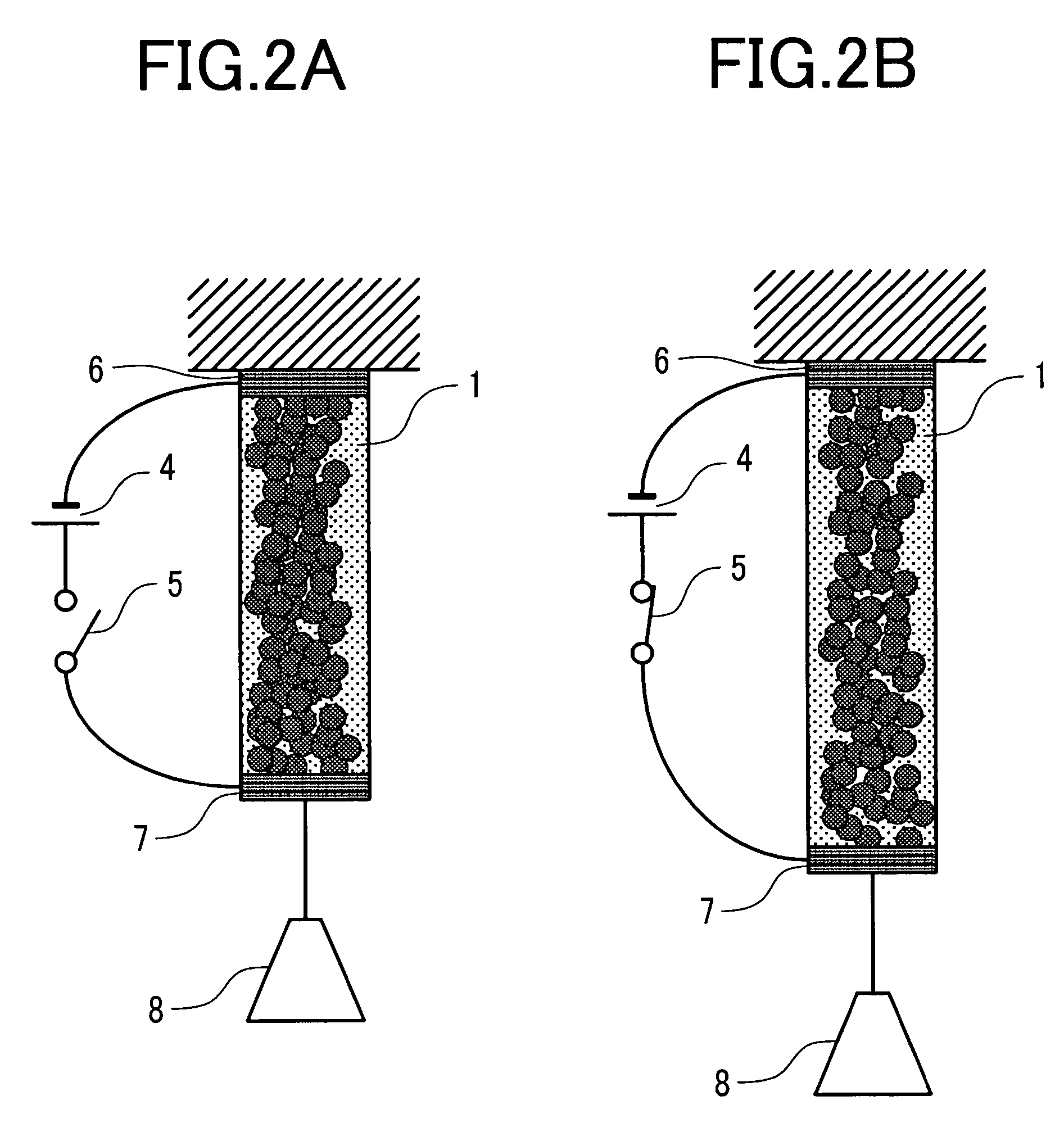Actuator and material for the actuator
a technology of actuators and actuators, applied in the field of actuator modules, can solve the problems of difficult control of temperature by heating under electric supply, slow response, and difficulty in obtaining large expansion and contraction within a practical temperature range, and achieve good controllability
- Summary
- Abstract
- Description
- Claims
- Application Information
AI Technical Summary
Benefits of technology
Problems solved by technology
Method used
Image
Examples
embodiment 1
[0049]In Embodiment 1, the concept of the basic operation of an actuator according to the invention and a manufacturing method thereof are to be described. At first, a description is to be made of the deformation of an actuator material when a voltage is applied to the actuator material constituting the actuator of the invention.
[0050]FIG. 1A schematically shows the state of an actuator material before voltage is applied thereto and FIG. 1B schematically shows the state of the actuator material when the voltage is applied. In the figures, are shown a polymer material 2 of large thermal expansion coefficient, fine conductive particles 3, and an actuator material 10 in which the fine conductive particles 3 are dispersed in the polymer material. There are also shown a power source 4 and a switch 5. Current can be supplied or stopped to the polymer material 10 by turning the switch 5 on or off. When a voltage of the power source 4 is applied to the actuator material 10 with the switch 5...
embodiment 2
[0079]In Embodiment 2, an actuator module structure using the actuator of the invention and an actuator matrix utilizing the same are to be described with reference to FIGS. 6A to 8B. FIGS. 6A and 6B are cross sectional views showing the concept of the actuator module structure of the invention in which FIG. 6A is a cross sectional view of an actuator module in a state before application of a voltage and FIG. 6B is a cross sectional view of the actuator module in a state upon application of the voltage. In an actuator module 60, a stretchable member 64 is disposed in an open plane of an elongate box-shaped container 65, and electrodes 62, 63 are buried in the bottom of the container 65. An actuator film 61 turned back at the central portion thereof is disposed inside the container 65, the turned back portion is joined to the lower surface of the stretchable member 64 at the upper surface of the container 65, and both ends of the actuator film 61 are joined with the respective electr...
embodiment 3
[0088]Embodiment 3 proposes a Braille display device as one of portable haptic devices as an application example of the actuator module shown in Embodiment 2, as well as a Braille display system using the same, which is to be described with reference to FIGS. 9A, 9B, 10A and 10B.
[0089]A Braille cell is expressed as a unit in which protrusions each having a height of about 0.4 mm are arranged about 2.2 mm apart to constitute a 3×2 dot matrix. The Braille display device of Embodiment 3 is a device in which six pins are arranged as a 3×2 matrix and an optional pin can be moved vertically at 0.4 mm stroke in response to electric signals.
[0090]A most simple Braille display device using the actuator module according to the invention is an actuator matrix using the actuator module 60 described in FIG. 6 for Embodiment 2 and arranging them in 3×2 arrangement. FIG. 9A is a conceptional view in which Braille display device 90 having actuator modules 60 arranged in 3×2 is viewed from above obl...
PUM
 Login to View More
Login to View More Abstract
Description
Claims
Application Information
 Login to View More
Login to View More - R&D
- Intellectual Property
- Life Sciences
- Materials
- Tech Scout
- Unparalleled Data Quality
- Higher Quality Content
- 60% Fewer Hallucinations
Browse by: Latest US Patents, China's latest patents, Technical Efficacy Thesaurus, Application Domain, Technology Topic, Popular Technical Reports.
© 2025 PatSnap. All rights reserved.Legal|Privacy policy|Modern Slavery Act Transparency Statement|Sitemap|About US| Contact US: help@patsnap.com



